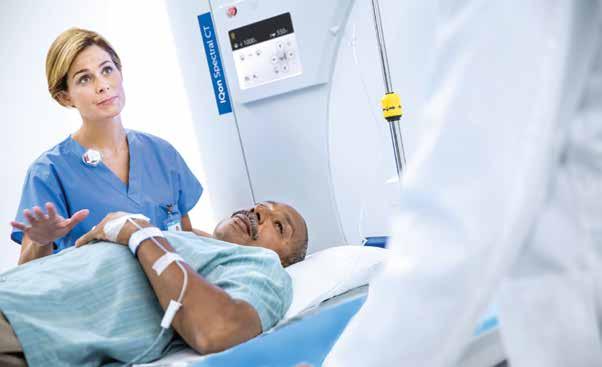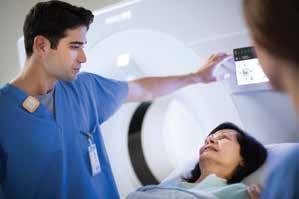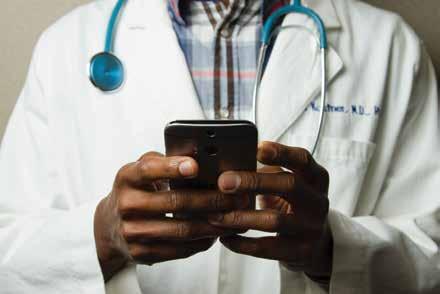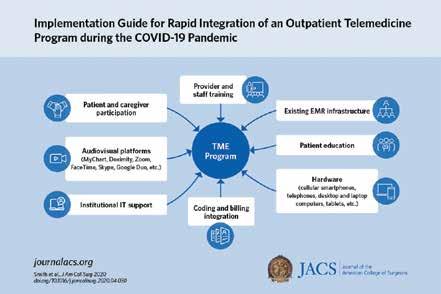
17 minute read
Next-gen micro-CT scan can lower radiation, offer better pictures
Imaging – Computed Tomography
indications and derive information that can help people better understand their overall health and risks of serious adverse events.”
The study used five AI computer programs on abdominal CT scans to accurately measure liver volume and fatty change, visceral fat volume, skeletal muscle volume, spine bone mineral density, and artery narrowing. Researchers found that not only did the combination of automated CT-based biomarkers compare favourably with the FRS and BMI for predicting cardiovascular events and death before any symptoms were present but in fact, the CT measure of aortic calcification, that is build-up of calcium deposits in the aortic valve, alone significantly outperformed the FRS for major cardiovascular events and overall survival.
With a five-year, $3.2 million grant from the US National Institute of Biomedical Imaging and Bioengineering,
Mini Das, associate professor of physics at the University of Houston, will help usher in the next generation of micro computed tomography (CT) imaging.
The project’s goal is to lower radiation dose in X-ray micro-CT imaging while improving the resolution and enhancing the contrast of three-dimensional pictures of small specimens, like tumours or biomaterials.
“This has the potential to transform the landscape of micro-CT imaging,” said Das, who recently developed the theory, instrumentation and algorithms for spectral phase-contrast imaging (PCI) to enable the use of much lower doses of radiation while delivering higher levels of image detail.
Das’s work addresses the challenge of current in-vivo micro-CT scanning – long imaging times, harmful, yet required, high radiation dose levels needed to follow the same subject over time, and poor image contrast.
“Current X-ray and CT systems have
The researchers also observed that BMI was a poor predictor of cardiovascular events and overall survival, and all five automated CT-based measures clearly outperformed BMI for adverse event prediction.
“This opportunistic use of additional CTbased biomarkers provides objective value to what doctors are already doing,” said Perry J. Pickhardt, M.D., of the University of Wisconsin School of Medicine & Public Health, lead and corresponding author of the study. “This automated process requires no additional time, effort, or radiation exposure to patients, yet these prognostic measures could one day impact patient health through presymptomatic detection of elevated cardiovascular or other health risks.”
This research builds on prior efforts deinherent contrast limitations and dense tissue and cancer can often look similar. Even if you increase the radiation dose, there is a limit to what you can see. In addition, image noise becomes significant when increasing resolution to see fine details, often desirable when scanning small objects,” said Das.
PCI detects how X-rays bend, or refract, particularly at the interface between tissues, providing a higher amount of contrast between different types of tissue. It also measures absorption and phase changes from X-ray transmission through the body. The resulting phase-enhanced contrast depicts high fine-structure visibility adding new image features. The developed methods can also translate to-large scale CT systems.
Detecting the bending of X-rays is challenging because the bend is small and they are both bending and being absorbed in tissues at the same time, complicating interpretation.
“X-rays, like visible light, exhibit what is called dual nature – they behave both as particles, called photons or packets of light, and waves. Phase imaging methods capture information relevant to wave nature of X-rays unlike conventional imagsigning AI algorithms that Dr Summers has undertaken in his lab in the NIH Clinical Center’s Radiology and Imaging Sciences Department and his previous collaboration with Dr Pickhardt to develop, train, test, and validate fully automated algorithms for measuring body composition using abdominal CT. The researchers plan to test the approach in other studies, including more racially diverse populations.
Reference:
Automated CT biomarkers for opportunistic prediction of future cardiovascular events and mortality in an asymptomatic screening population: a retrospective cohort study. The Lancet Digital Health. https://doi.
Next-gen micro-CT scan can lower radiation, offer better pictures
org/10.1016/S2589-7500(20)30025-X
University of Houston
University of Houston associate professor of physics Mini Das developed the theory, instrumentation and algorithms for spectral phasecontrast imaging (PCI) to enable the use of much lower doses of radiation while delivering higher levels of image detail in micro-CT scanning.
ing systems found in clinics today,” said Das.
Das is using a new multi-energy, or spectral, detector which can see the energy of every light particle and will develop a unique spectral micro-CT system with both PCI and non-PCI capabilities.
“We are the first to show how to use photon-counting detectors in a phasecontrast imaging setting while extracting the absorption and phase effects with quantitative accuracy. This accurate phase retrieval, or recovery, is so important if you want to discriminate between cancers and normal tissues,” she said.
Philips iQon Spectral CT – the first scan is the right scan

Conventional CT scans often produce ambiguous or inaccurate data that can require additional testing. As the world’s first spectral detector-based CT, the Philips IQon Spectral CT delivers multiple layers of retrospective data in a single, low-dose scan, empowering you to improve clinical confidence. The Philips IQon Spectral CT extends the benefits of spectral data to all patients, providing answers for even the most challenging scenarios. Now, every technician can acquire spectral data with every scan – data that can be viewed by care teams across your organization helping determine the best path for patient care.
Despite improvements in technology, making scans more efficient, for many patients, going to a hospital is still a stressful experience. Stress affects a patient’s ability to comply with staff requests and reducing that stress is key to making it easier for them to cooperate, thereby decreasing delays and retakes. Philips Ambient Experience solutions use dynamic lighting, projection and sound to give patients greater control and positive distractions during their journey. Patients become an active participant in the process and can personalize the imaging environment by selecting a journey, and concentrating on various elements of the selected theme, rather than the imposing equipment. This together with the “first scan is always the right scan” capabilities of Philips iQon can lead to a much improved patient experience. • For more information, visit: https://www.philips.ae/healthcare/resources/ landing/iqon-spectral-ct https://www.philips.ae/healthcare/consulting/ experience-solutions/ambient-experience/ radiology#radiology


Telemedicine
Study explores how telemedicine can ease ER overcrowding
Overcrowding in emergency rooms is a costly and concerning global problem, compromising patient care quality and experience. In a new study, a researcher from The University of Texas at Dallas investigated whether telemedicine could enhance ER care delivery.
“This longstanding problem is mainly driven by the imbalance between increasing patient flow and the shortage of emergency room capacity,” said Dr Shujing Sun, assistant professor of information systems in the Naveen Jindal School of Management and lead author of the study.
“While the ER is supposed to be a safety net of the health care system, the overcrowding problem has strained this safety net and posits various threats,” Sun said. “For example, long waiting times and treatment delays cause adverse patient outcomes, such as high readmission and mortality rates. They also increase financial costs, reduce patients’ satisfaction and impair physician efficiency.”
In the study, published in the September issue of Information Systems Research, Sun and her colleagues investigated the potential of telemedicine as a generic solution to reduce ER congestion.
Sun said telemedicine, defined as the remote delivery of health care services and clinical information using telecommunications technology, has been gradually adopted in recent years, but there is little evidence on the impact of its applications within the ER setting.
“Telemedicine application in the ER has two distinguishing features from homebased telemedicine,” Sun said. “First, patients present in the ER. Second, on-site assistance is available to connect patients and off-site physicians throughout the telemedicine service. Off-site physicians can be within the same hospital, in a different hospital, or even at home, as long as they can connect with emergency patients through videoconferencing tools and have access to patients’ health records.”
According to the National Hospital Ambulatory Medical Care Survey, from 2000 to 2015, the number of ER visits in the U.S. increased 27% from 108 million to nearly 137 million. With the sharp rise in ER visits and critical shortages of emergency care physicians, ER overcrowding is not abating, particularly as the Covid-19 pandemic strains the capacity of hospitals nationwide.

Benefits of telemedicine Using a large data set covering all emergency visits in New York state from 2010 to 2014, the researchers found that the adoption of telemedicine in the ER significantly shortened average length of stay and wait time.
ER telemedicine improves an oncall physician’s efficiency through transportation elimination and smoother workflow, which can shorten a patient’s wait for physicians.
For example, when there is an influx of emergency patients, telemedicine enables on-site nurse practitioners or physician assistants to treat patients with minor conditions under the remote supervision of off-site physicians. Sun said this is important because many hospitals require that all patients be seen by an attending physician. With telemedicine, on-call physicians can work from their office without travelling to the ER. Having an on-call physician available through telemedicine also can speed up the ordering of lab work, so that those processes can start long before they otherwise would, and physicians can pivot to their administrative tasks more quickly in between visits.
The researchers replicated the analysis using annual U.S. hospital data and found that ER telemedicine adoption significantly reduces average wait times documented in Medicare.gov’s Hospital Compare, or the average time a patient spends in the ER before being seen by a health care professional. That finding suggests that the reduction in length of stay – the total time from the first documented time after arrival at the ER to the time the patient is discharged from the ER – partially comes from the reduction of waiting time.
Flexible resource allocation Telemedicine could achieve greater efficiencies through several channels, Sun said. In addition to more efficient information exchange, the study showed
telemedicine can significantly improve ER care delivery through flexible resource allocation, especially when there is a shortage of on-site physician staffing or a hospital lacks certain expertise.
For example, whether to administer tissue plasminogen activator after stroke symptoms is a time-sensitive and complicated medical decision. However, some hospitals lack such expertise. Through a telestroke programme, a type of ER telemedicine application, on-site emergency physicians can immediately consult remote stroke specialists to perform real-time diagnoses and recommend treatment plans in a timely manner.
“Although the ER seems to be an unlikely place for telemedicine to play its role, it is happening, and in fact, is very promising,” Sun said. “We believe our findings are critical for ERs, considering the unique setting of unscheduled arrivals and unpredictability of patient traffic.” Stay-at-home orders caught many medical practices and healthcare systems off guard, leaving them ill-equipped to rapidly adopt an efficient telemedicine platform so they could keep providing time-sensitive care to non-Covid-19 patients. To help organizations rapidly introduce telemedicine as an alternative option, a urology group in North Carolina developed a guide that enabled them
It’s important to note that the improvement in care delivery does not come at the expense of care quality or patient cost, Sun said.
The study provides health care decisionmakers with a careful examination of the causal implications of ER telemedicine on care delivery efficiency, care quality and medical expenditure.
“Due to the lack of evidence and the inflexibility of reimbursement policy, the adoption rate of telemedicine in the ER remains low and is growing only slowly,” Sun said. “Policymakers can incentivize adoption of ER telemedicine by reducing regulatory barriers, such as lifting restrictions regarding cross-state practitioners’ licensure and providing better reimbursement coverage.”
With the current global Covid-19 pandemic and the expanded use of telemedicine applications in recent months, Sun said telemedicine has shown its promise to protect patients and providers without compromising healthcare access.
“When more and more hospitals join the resource-sharing network, telemedicine will have great potential to rebalance the geographically imbalanced health care resources and reduce healthcare access to convert all in-person visits to telemedicine in three days. They report their experience in an article in the Journal of the American College of Surgeons.
The guide, which the authors call a toolkit, uses a common electronic medical record (EMR) system, Epic, and widely available video portals like Google Duo and Doximity, to overcome social distancing disparity,” she said.
The use of telemedicine during the pandemic offers researchers an opportunity to take a more in-depth look. Sun plans to conduct further research to gather a better understanding of whether, how and why telemedicine functions in various healthcare situations.
Telemedicine Services
Telemedicine application relies on different types of communication modes, including real-time audio/visual communication, image transfer, telephone conversations and email. Examples: • Consultation between physicians. • Consultation between providers and patients. • Remote diagnosis by specialists relying on transferred images, records and laboratory results. • Remote mentoring specialists, such as for surgeons performing new
New toolkit provides rapid implementation guide for adopting telemedicine during Covid-19
Stepwise approach enabled telemedicine programme to get up and running in three days
or complicated procedures. edicts. The toolkit relies on eight essential elements readily available in any medical organization new to telemedicine.
“One of our motivations for preparing the toolkit was to make it instantly available to any type of organization, large or small, that has an electronic medical record system,” said lead author Catherine Matthews, MD, FACS, FACOG, professor
Telemedicine
of urology and gynaecology, Wake Forest Baptist Health, Winston-Salem, N.C.
Eight essential components The eight essential components to successful telemedicine adoption are: an existing EMR, a one-hour training session for providers and staff, patient education on accessing the portal, availability of hardware like smartphones and videocapable computers, integration of new billing and coding functions, information technology support, an audiovisual platform, and patient and caregiver buy-in.
“The first thing you have to figure out is which video platform is going to work most consistently,” Dr Matthews said. Through trial and error, she and her coauthors decided on pairing up the Epic EMR with the Doximity provider networking app. Patients can access the Doximity platform through a link sent in a text message, eliminating the need for them to download an additional app or log into an online portal.
The article acknowledges other options available for telemedicine: the MyChart video capability incorporated in the Epic EMR system, and even services such as FaceTime, Skype, WhatsApp, and Google Duo.
However, in reporting on their experience, the Wake Forest Baptist urology group found disadvantages to some of these alternatives. MyChart, for example, requires patients to sign up for the patient portal and download two separate apps. “It can take quite a bit of time for staff to educate patients about this option,” Dr Matthews said. “Patients not only have to have the device and Internet access; they have to have enough aptitude to complete those three separate steps.” For providers using their personal devices, platforms like FaceTime and Skype disclose their personal cell phone or e-mail information. Doximity masks that personal contact information with the organization’s office number.
Another key component is the ability to teach both staff and patients quickly how to use the technology. “After selecting the platform, engaging the office staff to be on board with virtual visits is the next most important step,” said coauthor Whitney

Implementation Guide for Rapid Integration of an Outpatient Telemedicine Program amidst the Covid-19 Pandemic.
Smith, MD, a fellow in the female pelvic health service at Wake Forest Baptist Health. Staff training involved a one-hour session with a mock patient visit. The goal, she said, was to replicate all the key steps of the in-person visit in the virtual visit, from front desk check-in and nurse chart review to exam and checkout.
“Telemedicine is currently built as a physician platform,” Dr Matthews said. “We changed it to be inclusive of nurses; we engaged our nursing staff into the platform so that they continue to do the same roles that they do in person.”
Connection process Days before the patient’s telemedicine appointment, a nurse calls to notify the patient the visit is being changed from an in-office to telemedicine, and then walks the patient through the connection process. On the day of the visit, the nurse calls again 15 minutes before the visit to review the chart, “just like they would if the patient was there in the office,” Dr Matthews said.
About three and a half weeks into their telemedicine experience, the Wake Forest Baptist Health urology physicians see about 15 patient visits via telemedicine a day compared to 30 in-office visits, Dr Smith added. Despite a lower total number of visits, Dr Matthews noted that a high rate of new telemedicine patient visits convert to surgery scheduling.
“Anecdotally, the efficiency from a surgical subspecialty perspective of the translation of new patient appointments to scheduling of future surgeries is currently 20 to 25 percent,” she said. “So a surgeon who’s not engaging in telemedicine is losing out on an opportunity to identify patients who will need surgery in the next two to three months.”
There have been barriers to wider implementation of telemedicine. Reimbursement for telemedicine services had been one. Another barrier can be technology. Small percentages of people still don’t have smartphones or home computers, and internet service can be limited, especially in some rural areas. Dr Smith said that the group had concerns about some elderly patients not having access to technology. “However, they’ve been able to engage younger family members to help them with the technology, and actually we’ve had very good success with that,” she said. For patients who don’t have video capability, the CMS waiver accommodates voice-only visits.
Reference: Implementation Guide for Rapid Integration of an Outpatient Telemedicine Program amidst the Covid-19 Pandemic. Journal of American College of Surgeons. • doi: https://doi.org/10.1016/j. jamcollsurg.2020.04.030.
Cisco
Now more than ever, healthcare matters

Patient health and well-being, and the ability to deliver secure virtual care is no longer a luxury – it’s a necessity. We’re at an unprecedented crossroads in healthcare in which new technologies are being adopted at a rapid pace, and the healthcare landscape is being forever altered.
Optimizing the clinical experience, scaling virtual consultations and empowering healthcare staff to work remotely is now critical to help save lives.
As we partner with healthcare providers worldwide to deliver quality, secure care today, we also look toward tomorrow by setting a strong foundation for future success. We’re a leader in healthcare transformation and we have the innovative solutions you need to deliver cutting-edge care. Every day, Cisco pushes the boundaries of what is possible in healthcare.
As a result of the health crisis, we’re seeing major shifts in the delivery of care, including the transition to telehealth, rapid deployment of temporary field hospitals and clinics, increased call center volumes and remote work.
Transition to telehealth To reduce physical contact between patients, clinicians and care teams, telehealth is quickly becoming the new normal. Both for primary care and for Covid-19 triage and evaluation, healthcare professionals are using Cisco Webex devices and Cisco Webex meeting and messaging platforms to securely consult with patients virtually.
Rapid deployment of temporary field hospitals To support a surge in demand for evaluation and testing while mitigating and preventing the spread of infectious disease, healthcare providers are setting up temporary, compartmentalized hospitals and clinics in mobile, pop-up and drivethrough locations. By connecting these temporary locations with existing hospital and clinical spaces through Meraki or Cisco networking products, healthcare providers can maintain isolation for high acuity patients. To accelerate deployment, Cisco Customer Experience provides customers with trusted expertise.
Increased call centre volumes Prior to visiting a hospital, clinic or temporary field hospital, symptomatic patients are being asked to first call a triage hotline. As a result, patients are turning to these contact centre agents to answer questions about symptoms, testing and treatment advice at greater volumes than ever before. Enabling remote work Businesses worldwide are implementing work from home mandates. But, what about clinicians and care teams in critical industries such as healthcare? We’re seeing many health systems empower both administrators and healthcare staff to work remotely when possible, arming clinicians with tools for telehealth and large-scale video broadcasts for knowledge distribution and health system-wide meetings.
To address these use cases and to share challenges, best practices and resources to keep up with healthcare today, we’re launching a new series entitled #HealthcareNow as part of a larger #PublicSectorNow series. • Contact us at Cisco and Logicom to learn more about Cisco Healthcare Solutions. We’re all in this together and we’re here to help. www.cisco.com
In times of uncertainty, one thing remains clear. There has never been a more critical time to focus on care delivery, clinical experience and healthcare innovation. • Explore how Cisco is transforming Healthcare. https://blogs.cisco.com/healthcare/ healthcare-now









